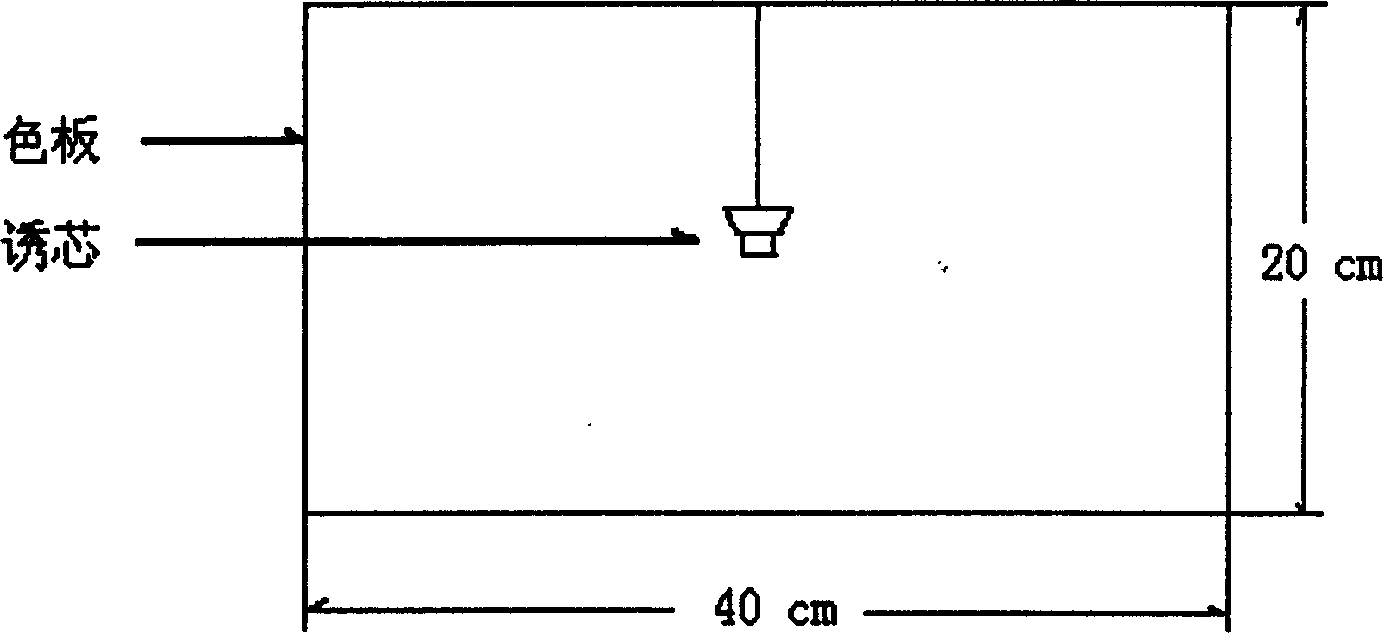Method for trapping Empoasca vitis Gothe imago/nymph and Aleurocanthus spiniferus imago
A technology for the false-eyed green leafhopper and black thorn whitefly, which is applied to the device, application, animal husbandry and other directions of catching or killing insects, can solve the problem of not involving the attracting effect of tea tip volatile matter and the like, and achieves low cost and convenience. The effect of transportation and stable performance
- Summary
- Abstract
- Description
- Claims
- Application Information
AI Technical Summary
Problems solved by technology
Method used
Image
Examples
Embodiment 1
[0047] Example 1: Using adsorption method to separate and identify 9 kinds of volatiles from robust tea shoots: trans-2-hexenal, ocimene, cis-3-hexenyl ethyl ester, cis-3-hexen-1-ol , 3-hexenyl butyrate, linalool, 1-octanol, geraniol and indole
[0048] Make a hollow glass column with a small opening of 7 mm in diameter at both ends, with a volume of 5 liters. The inlet is connected to a compressed air bottle, and the outlet is connected to a Tenax TA adsorption column and a vacuum pump in turn. The TenaxTA column was activated with nitrogen at 275°C for 4 hours prior to adsorption of volatiles. Add 200 grams of strong tea tip into the glass container, blow in air, and draw air from the back of the adsorption column at the same time, control the flow with a flow meter before the inlet and behind the Tenax TA column, and the air inlet and outlet flow rates are both 300 ml / min.
[0049] After 12 hours, the adsorption column was removed, rinsed with distilled ether, and then slo...
Embodiment 2
[0050] Example 2: Determination of cis-3-hexen-1-ol, trans-2-hexenal and linalool as volatile components with attractant activity by bioassay
[0051] According to specific embodiment 2, using n-hexane as a solvent, 9 kinds of tea volatiles such as cis-3-hexenal, trans-2-hexenal, and linalool were formulated into solutions at a concentration of 1 μg / ml, as a taste source, using n-hexane as a control, using a Y-shaped olfactometer to measure the number of leafhopper adults, leafhopper nymphs, and whitefly adults towards the taste source. It was found that among the nine tested volatiles, the number of leafhopper adults, leafhopper nymphs, and whitefly adults tending to cis-3-hexenal, trans-2-hexenal and linalool, compared with the tendency of the control ( n-hexane) the difference between the number of insects reached a significant level (P<0.05).
Embodiment 3
[0052] Embodiment 3: cis-3-hexen-1-ol, trans-2-hexenal and linalool are made into flavor sources with a concentration of 0.01-20 μg / ml respectively, and then the three flavor sources are pressed 1: 0.2-1.5: 0.1-1 combination, prepared as attractant
[0053] Using n-hexane as a solvent, make cis-3-hexenal ethanol, trans-2-hexenal and linalool respectively into flavor sources with a concentration of 1 μg / ml, and then mix the three flavor sources at a ratio of 1:1 : 1 ratio combination, the bioassay by the "Y" shape olfactometer shows that the attracting effect is stronger than that of the single component. This is the attractant for the adults, nymphs and adults of the leafhopper and the adult blackleaf.
[0054] Soak rubber tips made of natural rubber in absolute ethanol for 24 hours and let dry. Soak such rubber head with attractant again for 24 hours, just made lure core.
PUM
| Property | Measurement | Unit |
|---|---|---|
| Caliber | aaaaa | aaaaa |
Abstract
Description
Claims
Application Information
 Login to View More
Login to View More - R&D
- Intellectual Property
- Life Sciences
- Materials
- Tech Scout
- Unparalleled Data Quality
- Higher Quality Content
- 60% Fewer Hallucinations
Browse by: Latest US Patents, China's latest patents, Technical Efficacy Thesaurus, Application Domain, Technology Topic, Popular Technical Reports.
© 2025 PatSnap. All rights reserved.Legal|Privacy policy|Modern Slavery Act Transparency Statement|Sitemap|About US| Contact US: help@patsnap.com


